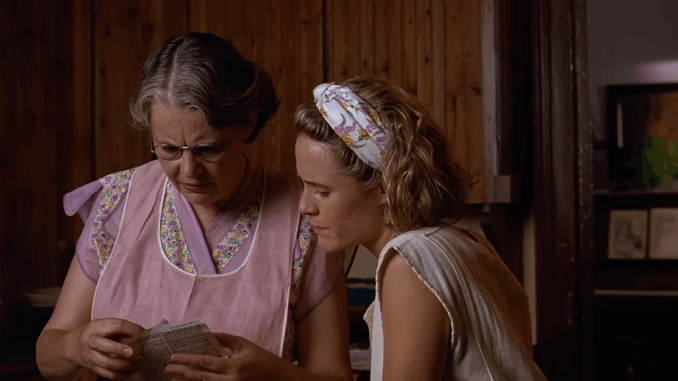
As Hollywood continues to chase franchises, box office records, and cinematic spectacle, an unlikely title keeps appearing in retrospectives and film schools alike: Fried Green Tomatoes (1991). Released without fanfare during a crowded awards season, the Jon Avnet-directed drama quietly carved a place for itself in American film history. Now, more than three decades later, critics are calling it a “blueprint for meaningful storytelling” — and the industry is finally paying attention.
So how did a modest, Southern-set film about aging, storytelling, and a café in Alabama become one of the most quietly influential dramas in modern cinema?
Small Town, Big Impact
Fried Green Tomatoes defied the odds from the beginning. It had no explosions, no major stunts, no male saviors. What it had were four powerful performances, a dual-timeline narrative, and an emotional center strong enough to carry an entire generation.
Starring Kathy Bates, Jessica Tandy, Mary Stuart Masterson, and Mary-Louise Parker, the film tells the story of Evelyn Couch, a housewife who finds her sense of self through the stories of Ninny Threadgoode, an elderly woman whose recollections of life in Whistle Stop, Alabama — especially the fierce friendship between Idgie and Ruth — reshape Evelyn’s own path.
But what industry insiders and scholars have come to recognize is that Fried Green Tomatoes wasn’t just heartwarming. It was revolutionary.
A Quiet Disruption of Hollywood Norms
In the early 1990s, women-led stories were often romantic comedies or tearjerkers. Fried Green Tomatoes was neither. It was a genre-blending piece that walked the line between drama, mystery, and period piece — all centered on women’s lives without ever reducing them to stereotypes.
“The studio didn’t know how to market it,” recalls producer Lisa Lindstrom. “They were worried it was too ‘small’ to succeed. But it ended up being a word-of-mouth hit.”
Indeed, the film earned over $100 million globally, was nominated for two Academy Awards, and became a VHS classic. But its true legacy wasn’t in the numbers — it was in the structure. Long before The Notebook or Big Fish popularized time-hopping narratives with emotional resonance, Fried Green Tomatoes had already perfected it.
The Blueprint for Modern Nostalgia

Hollywood’s current obsession with nostalgia — from This Is Us to Daisy Jones & The Six — owes a quiet debt to Fried Green Tomatoes. Its non-linear storytelling, layered emotional beats, and intergenerational bonds laid the groundwork for how deeply personal stories could unfold cinematically.
“It proved that memory could be as dramatic as action,” said screenwriting professor Dr. Jonah Klein of UCLA. “That a conversation on a porch could have the same emotional weight as a chase scene — if done right.”
And done right it was. The screenplay, co-written by Avnet and based on Fannie Flagg’s novel, is now studied in screenwriting classes for its use of nested narratives, symbolism, and thematic closure.
A Landmark for Queer-Coded Storytelling
Even more significant is the way the film handled LGBTQ+ representation — especially in a time when openly queer characters were rare in mainstream cinema.
While the romantic nature of Idgie and Ruth’s relationship was toned down from the book (to appease censors and ensure marketability), the chemistry and love between the two women has since become iconic among queer audiences. The ambiguity itself became a conversation starter and a case study in how queer stories were often smuggled into the mainstream via coded relationships.
“It’s a classic example of ‘the love that couldn’t speak its name’ — but still found its voice,” said GLAAD film historian Mara Reyes. “It’s bittersweet, but also groundbreaking.”
Industry Interest Reignited
Now, in 2025, the film’s legacy is being reevaluated in powerful ways. Netflix has reported a major spike in viewership following its digital re-release, and several production companies are reportedly in talks to develop a limited series adaptation — one that leans further into the racial and queer themes only hinted at in the original.
More significantly, Fried Green Tomatoes is being embraced by a new generation of filmmakers — especially women, queer creators, and Southern artists — who cite it as an inspiration.
“Fried Green Tomatoes gave us permission to write slow stories,” says indie director Alina Brooks. “Stories where the drama is in the memory, in the gesture, in the food. It taught us that softness is not weakness — it’s cinematic.”
A Legacy That’s Still Cooking
In a way, Fried Green Tomatoes is an act of resistance. It resists spectacle in favor of soul. It resists stereotypes in favor of complexity. And it resists fading into history — because every time it’s watched, it feels new again.
There may never be a sequel or franchise spin-off (though there’s certainly talk), but its influence is already everywhere. In every series that blends timelines. In every film that dares to center middle-aged women. In every queer story that refuses to shout — and instead, lets the love speak for itself.
In Hollywood, the loudest stories often get the spotlight. But sometimes, the quiet ones leave the deepest mark. Fried Green Tomatoes is proof of that — and it’s still making ripples, one story at a time.
